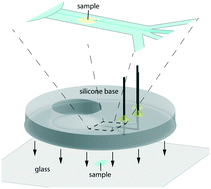A simple microfluidic platform for the partial treatment of insuspendable tissue samples with orientation control†
Abstract
Microfluidic devices have extensively been applied to study biological samples, including single cells. Exploiting laminar flows on a small scale, microfluidics allow for the selective and partial exposure of samples to various chemical treatments. Traditionally, suspendable samples are first flowed into formed microchannels and are allowed to adhere to the channel floor randomly with no control over sample placement or orientation, before being subjected to partial treatment. This severely limits the choice of samples and the extent of sample preparations. Here, we overcame this limit by reversing the sequence. We prepared the samples first on glass substrates. A patterned silicone slab was then placed on the substrate to form channels at an appropriate orientation with respect to the sample. We used liquid silicone rubber (LSR) as the base material. Its compliance (low elastic modulus) and its adhesion to glass offer the necessary seal to form the microchannels naturally. The applicability of the device was demonstrated by testing single axons of embryonic Drosophila motor neurons in vivo. A segment of the axons was subjected to drugs that inhibit myosin activities or block voltage-gated sodium ion channels. In response, the axons reduced the clustering of neuro-transmitter vesicles at the presynaptic terminal of neuromuscular junctions, or increased the calcium intake and underwent membrane hyperpolarization, respectively. Such fundamental studies cannot be carried out using conventional microfluidics.



 Please wait while we load your content...
Please wait while we load your content...